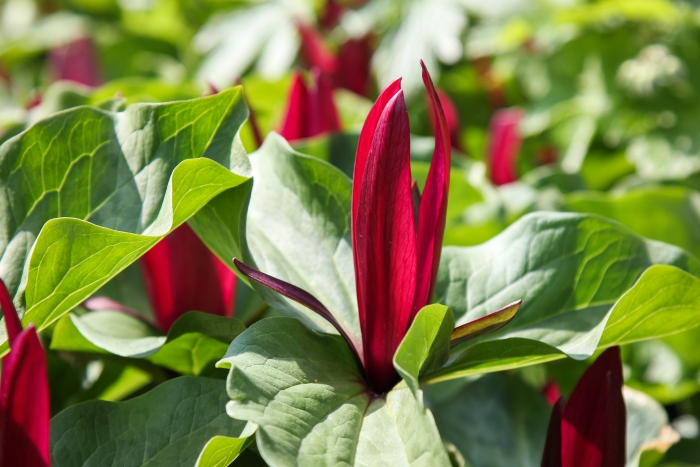Giant Purple Wakerobin
(Trillium kurabayashii)
Giant Purple Wakerobin (Trillium kurabayashii)
/
/

Maja Dumat
CC BY 2.0
Image By:
Maja Dumat
Recorded By:
Copyright:
CC BY 2.0
Copyright Notice:
Photo by: Maja Dumat | License Type: CC BY 2.0 | License URL: https://creativecommons.org/licenses/by/2.0/ | Uploader: blumenbiene | Publisher: Flickr |


















Estimated Native Range
Summary
Trillium kurabayashii, commonly known as Giant Purple Wakerobin, is a deciduous perennial herb that thrives in the understory of mixed evergreen and deciduous forests, as well as in moist, shaded bogs in California and Oregon. It is characterized by a whorl of three large, broadly ovate leaves and a striking solitary flower. The flower, which blooms in early to mid-spring, is notable for its deep purple to reddish petals, lack of a stalk, and its three sepals, stamens, and carpels, which contribute to its symmetrical, trimerous appearance. The plant typically reaches a height and width of 1-2 feet.
Giant Purple Wakerobin is valued for its large, showy flowers and its ability to add a splash of color to shady garden spots. It is often used in woodland gardens, naturalized areas, and as an understory plant in shaded borders. While it prefers part shade to full shade, it requires consistently moist soil with good drainage to thrive. It is not drought-tolerant and should be watered regularly during dry periods. The plant’s historical cultivation success is attributed to Gilman Keasey, who propagated it from seed, resulting in a significant increase in available plants by 1968. Despite its beauty, Trillium kurabayashii can be susceptible to slug and snail damage, and over-collection in the wild has led to conservation concerns. Gardeners are encouraged to purchase from reputable nurseries to avoid contributing to the depletion of native populations.CC BY-SA 4.0
Giant Purple Wakerobin is valued for its large, showy flowers and its ability to add a splash of color to shady garden spots. It is often used in woodland gardens, naturalized areas, and as an understory plant in shaded borders. While it prefers part shade to full shade, it requires consistently moist soil with good drainage to thrive. It is not drought-tolerant and should be watered regularly during dry periods. The plant’s historical cultivation success is attributed to Gilman Keasey, who propagated it from seed, resulting in a significant increase in available plants by 1968. Despite its beauty, Trillium kurabayashii can be susceptible to slug and snail damage, and over-collection in the wild has led to conservation concerns. Gardeners are encouraged to purchase from reputable nurseries to avoid contributing to the depletion of native populations.CC BY-SA 4.0
Plant Description
- Plant Type: Herb
- Height: 1-2 feet
- Width: 1-2 feet
- Growth Rate: Slow
- Flower Color: Purple, Red
- Flowering Season: Spring
- Leaf Retention: Deciduous
Growth Requirements
- Sun: Part Shade, Full Shade
- Water: Medium
- Drainage: Medium
Common Uses
Bee Garden, Deer Resistant, Low Maintenance
Natural Habitat
Mixed evergreen and decidaceous forests and moist, shaded bogs
Other Names
Common Names:
Scientific Names: , Trillium kurabayashii, Trillium kurabayashii f. luteum,
GBIF Accepted Name: Trillium kurabayashii J.D.Freeman